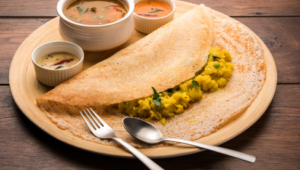Dosa, a beloved South Indian delicacy, has transcended regional boundaries to become a breakfast favorite for many around the globe. Its unique combination of taste, texture, and nutritional benefits makes it stand out as an ideal morning meal. But what is it about this crispy, golden-brown crepe that has captivated the hearts and palates of so many? Let’s delve deep into the world of dosa to understand its widespread appeal as the quintessential the best breakfast dish.
The Origins and Evolution of Dosa

Dosa’s rich history dates back over a millennium. Originating from the temple streets of Udupi in Karnataka, India, references to dosa can be found in Tamil literature as early as the 5th century AD. The Chalukya King Somesvara III documented this dish in 1054 AD, highlighting its longstanding presence in South Indian cuisine.
Initially a simple rice and lentil crepe, dosa has undergone numerous transformations, resulting in a plethora of variations that cater to diverse tastes and preferences.
Nutritional Powerhouse: Health Benefits of Dosa
Beyond its delectable taste, dosa offers a range of health benefits that make it a preferred breakfast choice:
- Rich in Carbohydrates: Dosa provides a substantial amount of carbohydrates, offering the energy needed to kickstart your day.
- High Protein Content: The combination of rice and urad dal (black gram lentils) in the batter ensures a good protein intake, essential for muscle repair and growth.
- Low in Calories: A plain dosa contains approximately 37 calories, making it a light yet fulfilling meal option.
- Easily Digestible: The fermentation process breaks down starches, aiding in digestion and promoting gut health.
- Gluten-Free: Naturally free from gluten, dosa is an excellent choice for those with gluten sensitivities or celiac disease.
Culinary Versatility: A Dosa for Every Palate
One of the reasons for dosa’s universal appeal is its adaptability. From traditional recipes to innovative twists, there’s a dosa for everyone:
- Masala Dosa: Stuffed with a spiced potato filling, this variant offers a flavorful and hearty experience.
- Rava Dosa: Made from semolina, it delivers a delicate, crunchier texture, light and airy with every bite.
- Paper Dosa: Known for its thin and crispy texture, it’s a delight for those who enjoy a crunchy bite.
- Set Dosa: Softer and thicker, often served in a set of three, perfect for soaking up accompanying chutneys and sambar.
- Benne Dosa: A specialty from Karnataka, enriched with butter, offering a rich and indulgent flavor.
Cultural Significance and Global Popularity
Dosa is more than just a dish; it’s a cultural emblem of South India. Traditionally consumed for breakfast or as a snack, its popularity has soared globally. In cities like Dublin, restaurants such as Andhra Bhavan offer South Indian breakfast thalis, introducing locals to the diverse flavors of dosa.
In the United States, brands like Dosa Kitchen are making it easier for households to prepare dosa at home, further cementing its place in global cuisine.
Expert Insights: Why Dosa Stands Out
Nutritionists and culinary experts laud dosa for its balanced nutritional profile and versatility. The fermentation process not only enhances its flavor but also increases its nutrient bioavailability. Moreover, its adaptability to various dietary preferences be it vegan, gluten-free, or high-protein makes it a universally appealing dish.
Conclusion
Dosa’s enduring popularity is a testament to its perfect blend of taste, health benefits, and versatility. Whether you’re savoring a traditional masala dosa in a South Indian home or trying a fusion variant in a modern café, this dish offers a delightful culinary experience that caters to both the palate and well-being. Incorporating dosa into your breakfast routine not only connects you to a rich cultural heritage but also provides a nutritious and satisfying start to your day.
So, the next time you’re pondering over breakfast options, remember the humble dosa a dish that has stood the test of time and continues to win hearts worldwide.

